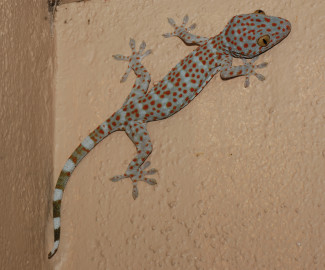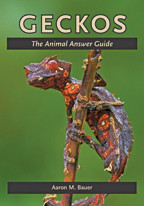
Johns Hopkins UniversityEst. 1876
America’s First Research University
Wild Thing: Q&A from Geckos: The Animal Answer Guide
Wild Thing is an occasional series where JHU Press authors write about the flora and fauna of the natural world—from the rarest flower to the most magnificent beast.
Today in Wild Thing, take a glimpse into the fascinating world of geckos with a Q&A from Geckos: The Animal Answer Guide, by Aaron M. Bauer.

A. Geckos have large eyes, on average larger than any other group of lizards. This is related to their nocturnal history as a group, because larger eyes are advantageous for night vision. The size of the orbits in the skulls of some fossil gekkotans reveals that this was a feature of even the earliest members of the group. Eye size is greatest among terrestrial species of nocturnal geckos. Israeli herpetologist Yehudah Werner hypothesized that this may be to compensate for the ground-dwellers’ more limited field of vision. Incidentally, he also proposed that the elevated posture that many ground geckos adopt is also related to increasing the field of vision. Diurnal geckos typically have smaller eyes than their night-active relative, but these are still larger than those of lizards in ancestrally diurnal relatives.
Q. How strong is a gecko’s grip?
A. Geckos are theoretically able to hold on with a force that greatly exceeds that necessary to support their own body mass. Different studies have indicated that this amount is from several hundredfold to four-thousand-fold or, for a 1.75 ounce (50 gram) Tokay Gecko, sufficient to support the weight of about three 150 pound (70 kilogram) adult humans! This overdesign is probably because the natural surfaces that they move on are really quite uneven and rough at the scale of the setal tips. This means that only a small proportion of the gecko’s possible points of attachment will really be used as it climbs on a particular surface and that even this fraction of adhesive surface must be capable of supporting the entire animal. Further, at times in the gecko's stride only one foot, or even one toe, may be supporting the entire body. The amazing capacity of the gecko's grip has inspired humans to search for new and better artificial adhesives.

Q. Can geckos change color?
A. Although they are not as accomplished as chameleons and none can change to match their background exactly, some geckos do change color. Most geckos can at least lighten and darken in response to temperature, light, and “emotional” state. Warm geckos, in the dark, that are not stressed are usually pale. Cold animals, in light, or in a disturbed or stressed state tend to be darker. This change can happen over a period of minutes (or seconds in some cases) to hours. Some geckos appear whitish, pale pinkish, or almost transparent in their palest state. In many others, the full complexity of their patterns can only be seen in this paler state, whereas the darker phase obscures pattern elements and can make even a brightly colored gecko appear drab. An extreme occurs in Pachydactylus bicolor, a gecko from Namibia. In its dark phase, it is a chocolate brown with small yellowish or brownish flecks, but when it lightens a complex pattern of bands and blotches emerges. Males of at least some sexually dichromatic Gonatodes, like G. humeralis, rapidly change color from drab to brightly colored in the presence of rival males, however, the females remain drab all the time and are incapable of color change. These changes can be triggered by hormones or by signals from the nervous system. Change in state of health can also change color; for example, a heavy parasite load can dull the colors of normally bright males.
Q. Do geckos play?
A. Probably not, but it is hard to know for certain. Play behavior is well documented in birds and mammals, but in reptiles it has been tentatively identified in only a few species, mostly turtles, under captive conditions. Even in these cases, it was difficult to distinguish play from other types of exploratory behavior. Scientists generally believe that factors such as high metabolic rate, endothermy (the ability to generate heat internally), and extensive parental care, which provide animals with surplus resources are usually necessary for play to evolve. Geckos explore their environment and may be “curious” about unfamiliar objects or organisms. However, most of this curiosity is almost certainly related to basic life functions. In other words, geckos want to know things like “Can I eat it?” “Will it try to eat me?” or “Can I mate with it?” Or, in the case of inanimate objects “Can it help or hinder me from eating, mating, or hiding?” Although there is a tendency for some people to interpret the behavior of their pet geckos as play, other more practical explanations probably apply.
Q. Are any geckos cannibals?
A. Like other lizards, many geckos will take advantage of smaller individuals of their own species as food sources. In the wild some geckos, such as the Indian Hemidactylus prashadi, may segregate microhabitat by age class in order to prevent juveniles from coming in contact with hungry adults until they reach larger sizes. Cannibalism in geckos is rarely documented in the wild, except for easily observed house geckos, but it undoubtedly occurs, with its likelihood increasing in times of food shortages and under crowded conditions. The cramped conditions of captivity increase the risk of cannibalism. It has been recorded in at least ten species of geckos, including some that are otherwise unknown to take vertebrate prey. With few exceptions, it is generally safest to keep hatchling and juvenile geckos separate from adults, as even parents will devour their own offspring.



